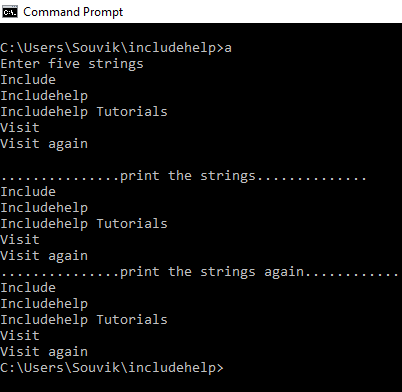C 中的 rewind() 函数
rewind() 函数定义在<stdio.h>头文件。
原型:
void rewind(FILE *filename);
参数: FILE *filename
返回类型: void
函数的使用:
当我们处理文件时,有时我们需要启动指定的文件。在文件处理中,我们使用 rewind() 函数将文件位置指示器移动到指定文件流的开头。函数 rewind() 的原型是void rewind(FILE *filename);
这里,filename是文件指示器开始的文件的名称。通过该函数,文件结束和错误标志被清除。
C 中的 rewind() 示例
#include <stdio.h>
#include <stdlib.h>
int main()
{
//Initialize the file pointer
FILE* f;
char ch[100];
//Create the file for write operation
f = fopen("includehelp.txt", "w");
printf("Enter five strings\n");
for (int i = 0; i < 4; i++) {
//take the strings from the users
scanf("%[^\n]", &ch);
//write back to the file
fputs(ch, f);
//every time take a new line for the new entry string
//except for last entry.Otherwise print the last line twice
fputs("\n", f);
//clear the stdin stream buffer
fflush(stdin);
}
//take the strings from the users
scanf("%[^\n]", &ch);
fputs(ch, f);
//close the file after write operation is over
fclose(f);
//open a file
f = fopen("includehelp.txt", "r");
printf("\n...............print the strings..............\n");
while (!feof(f)) {
//takes the first 100 character in the character array
fgets(ch, 100, f);
//and print the strings
printf("%s", ch);
}
rewind(f);
printf("\n...............print the strings again..............\n");
while (!feof(f)) {
fgets(ch, 100, f);
printf("%s", ch);
}
//close the file
fclose(f);
return 0;
}输出

相关用法
- C语言 remove()用法及代码示例
- C语言 rename()用法及代码示例
- C语言 fread()用法及代码示例
- C语言 feof()用法及代码示例
- C语言 imagesize()用法及代码示例
- C语言 getarcoords()用法及代码示例
- C语言 strcspn()用法及代码示例
- C语言 setlinestyle()用法及代码示例
- C语言 showbits()用法及代码示例
- C语言 sprintf()用法及代码示例
- C语言 outtextxy()用法及代码示例
- C语言 isgraph()用法及代码示例
- C语言 grapherrormsg()用法及代码示例
- C语言 moveto()用法及代码示例
- C语言 putchar()用法及代码示例
- C语言 tmpnam()用法及代码示例
- C语言 putpixel()用法及代码示例
- C语言 fillellipse()用法及代码示例
- C语言 outtext()用法及代码示例
- C语言 atan2()用法及代码示例
注:本文由纯净天空筛选整理自Souvik Saha大神的英文原创作品 rewind() function in C language with Example。非经特殊声明,原始代码版权归原作者所有,本译文未经允许或授权,请勿转载或复制。
